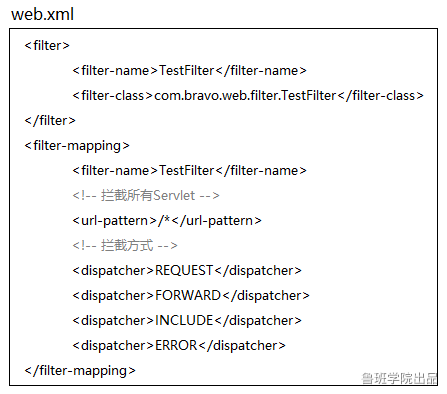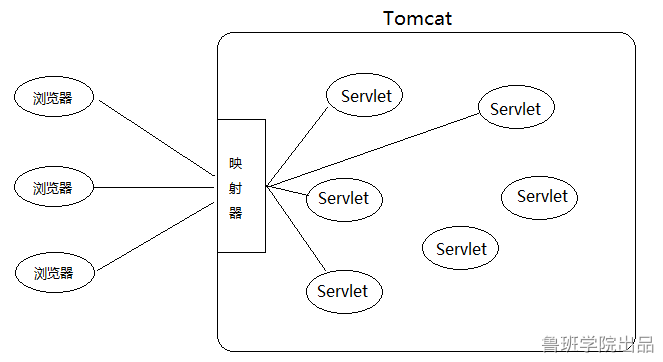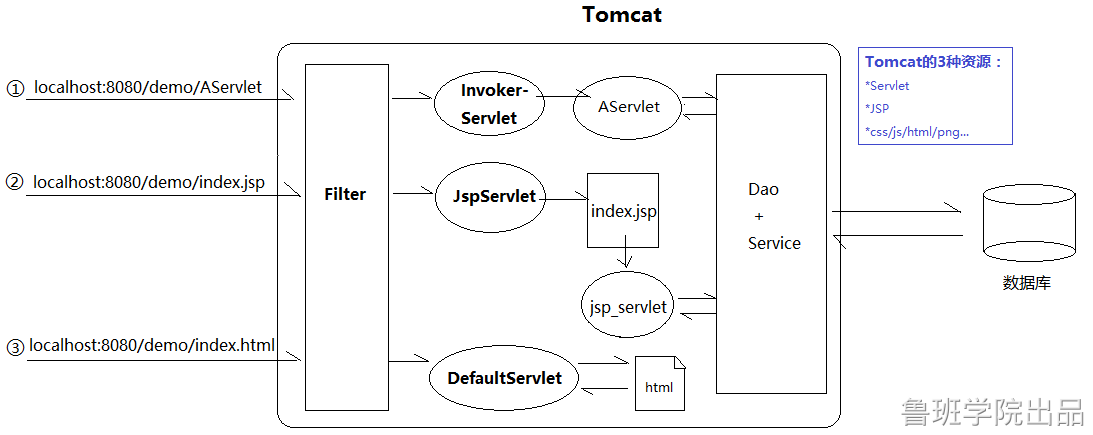01-Servlet 回顾
通过url访问资源有三个步骤:
接收请求
处理请求
响应请求
web服务器:将某个主机上的资源映射为一个URL供外界访问,完成接收和响应请求
servlet容器:存放着servlet对象(由程序员编程提供),处理请求
Servlet接口
Servlet接口定义了5种方法:
- init()
- service()
- destroy()
- getServletConfig()
- getServletInfo()
package javax.servlet;
import java.io.IOException;
public interface Servlet {
//tomcat反射创建servlet之后,调用init方法传入ServletConfig,对于每一个Servlet实例,init()方法只能被调用一次
void init(ServletConfig config) throws ServletException;
//该方法返回容器调用init()方法时传递给Servlet对象的ServletConfig对象,ServletConfig对象包含了Servlet的初始化参数。
ServletConfig getServletConfig();
//tomcat解析http请求,封装成对象传入,容器调用service()方法来处理客户端的请求
void service(ServletRequest var1, ServletResponse var2) throws ServletException, IOException;
String getServletInfo();
void destroy();
}
ServletConfig:
封装了servlet的参数信息,从web.xml中获取,init-param标签的参数
<!--注册servlet-->
<servlet>
<!--为Servlet注册一个友好的名字-->
<servlet-name>HelloServlet</servlet-name>
<!--指明为哪一个Servlet类起个友好的名字,名字要写全限定名-->
<servlet-class>com.yoocar.servlet.HelloServlet</servlet-class>
<!--配置参数-->
<init-param>
<param-name>user</param-name>
<param-value>root</param-value>
</init-param>
<init-param>
<param-name>pwd</param-name>
<param-value>123456</param-value>
</init-param>
<!--标签中间写的值,必须是正整数,数字越小,优先级越高-->
<load-on-startup>1</load-on-startup>
</servlet>
获取ServletConfig
public class HelloServlet extends HttpServlet {
//在servlet的整个生命周期内,servlet的init()方法,只会被调用一次,就是在第一次访问的时候
@Override
public void init() throws ServletException {
super.init();
System.out.println("HttpServlet-------------init");
}
/**
*
* @param request 获得浏览器请求
* @param response 获得服务器响应
* @throws ServletException
* @throws IOException
*/
@Override
protected void doGet(HttpServletRequest request, HttpServletResponse response) throws ServletException, IOException {
Object count = request.getSession().getAttribute("Count");
System.out.println("count==="+count);
//获取ServletConfig对象
getServletConfig();
try {
String userId = request.getParameter("userId");
System.out.println(userId);
String servletPath = this.getServletContext().getRealPath("/");
System.out.println(servletPath);
//获取回应,以便向浏览器写数据
OutputStream out = response.getOutputStream() ;
//写数据
out.write("hello Servlet".getBytes());
//关闭流
out.close();
} catch (Exception e) {
// TODO: handle exception
}
}
//获取ServletConfig对象
@Override
public ServletConfig getServletConfig() {
ServletConfig servletConfig = super.getServletConfig();
Enumeration<String> initParameterNames = servletConfig.getInitParameterNames();
while(initParameterNames.hasMoreElements()){
//获取init-param标签配置的参数param-name
String element = initParameterNames.nextElement();
System.out.println("param-name--------"+element);
String value = servletConfig.getInitParameter(element);
System.out.println("param-value--------"+value);
}
return servletConfig;
}
}
ServletRequest:
http请求到了tomcat后,tomcat通过字符串解析,把各个请求头(header),请求地址(URL),请求参数(queryString)都封装进Request。
ServletResponse:
Response在tomcat传给servlet时还是空的对象,servlet逻辑处理后,最终通过response.write()方法,将结果写入response内部的缓冲区,tomcat会在servlet处理结束后拿到response,获取里面的信息,组装成http响应给客户端
GenericServlet
改良版的servlet,抽象类,将ServletConfig提取出来,提升ServletConfig作用域,由局部变量变成全局变量
public abstract class GenericServlet implements Servlet, ServletConfig, Serializable {
private static final long serialVersionUID = 1L;
//将ServletConfig提取出来
private transient ServletConfig config;
public GenericServlet() {
}
//并不是销毁servlet的方法,而是销毁servlet前一定会调用的方法。默认空实现,可以借此关闭一些资源
public void destroy() {
}
public String getInitParameter(String name) {
return this.getServletConfig().getInitParameter(name);
}
public Enumeration<String> getInitParameterNames() {
return this.getServletConfig().getInitParameterNames();
}
//初始化时已被赋值
public ServletConfig getServletConfig() {
return this.config;
}
//通过ServletConfig获取ServletContext
public ServletContext getServletContext() {
return this.getServletConfig().getServletContext();
}
public String getServletInfo() {
return "";
}
//提升ServletConfig作用域,由局部变量变成全局变量
public void init(ServletConfig config) throws ServletException {
this.config = config;
//提供给子类覆盖
this.init();
}
public void init() throws ServletException {
}
public void log(String message) {
this.getServletContext().log(this.getServletName() + ": " + message);
}
public void log(String message, Throwable t) {
this.getServletContext().log(this.getServletName() + ": " + message, t);
}
//空实现
public abstract void service(ServletRequest var1, ServletResponse var2) throws ServletException, IOException;
public String getServletName() {
return this.config.getServletName();
}
}
HttpServlet
GenericServlet的升级版,针对http请求所定制,在GenericServlet的基础上增加了service方法的实现,完成请求方法的判断
抽象类,用来被子类继承,得到匹配http请求的处理,子类必须重写以下方法中的一个
doGet,doPost,doPut,doDelete 未重写会报错(400,405)
service方法不应该重写,tomcat会为每一个HttpServlet创建单例
模板模式实现
public void service(ServletRequest req, ServletResponse res) throws ServletException, IOException {
HttpServletRequest request;
HttpServletResponse response;
try {
request = (HttpServletRequest)req;//强转成http类型,功能更强大
response = (HttpServletResponse)res;
} catch (ClassCastException var6) {
throw new ServletException(lStrings.getString("http.non_http"));
}
//每次都调,关键代码
this.service(request, response);
}
protected void service(HttpServletRequest req, HttpServletResponse resp) throws ServletException, IOException {
//获取请求方式
String method = req.getMethod();
long lastModified;
//判断逻辑,调用不同的处理方法
if (method.equals("GET")) {
lastModified = this.getLastModified(req);
if (lastModified == -1L) {
//本来业务逻辑应该直接写在这里,但是父类无法知道子类具体的业务逻辑,所以抽成方法让子类重写,父类的默认实现输出405,没有意义
this.doGet(req, resp);
} else {
long ifModifiedSince;
try {
ifModifiedSince = req.getDateHeader("If-Modified-Since");
} catch (IllegalArgumentException var9) {
ifModifiedSince = -1L;
}
if (ifModifiedSince < lastModified / 1000L * 1000L) {
this.maybeSetLastModified(resp, lastModified);
this.doGet(req, resp);
} else {
resp.setStatus(304);
}
}
} else if (method.equals("HEAD")) {
lastModified = this.getLastModified(req);
this.maybeSetLastModified(resp, lastModified);
this.doHead(req, resp);
} else if (method.equals("POST")) {
this.doPost(req, resp);
} else if (method.equals("PUT")) {
this.doPut(req, resp);
} else if (method.equals("DELETE")) {
this.doDelete(req, resp);
} else if (method.equals("OPTIONS")) {
this.doOptions(req, resp);
} else if (method.equals("TRACE")) {
this.doTrace(req, resp);
} else {
String errMsg = lStrings.getString("http.method_not_implemented");
Object[] errArgs = new Object[]{method};
errMsg = MessageFormat.format(errMsg, errArgs);
resp.sendError(501, errMsg);
}
}
一个类被声明为抽象的,一般有两个原因:
- 有抽象方法需要被实现
- 没有抽象方法,但是不希望被实例化
public abstract class HttpServlet extends GenericServlet
ServletContext
servlet上下文,代表web.xml文件,其实就是一个map,服务器会为每个应用创建一个servletContext对象:
- 创建是在服务器启动时完成
- 销毁是在服务器关闭时完成
javaWeb中的四个域对象:都可以看做是map,都有getAttribute()/setAttribute()方法。
ServletContext域(Servlet间共享数据)
Session域(一次会话间共享数据,也可以理解为多次请求间共享数据)
Request域(同一次请求共享数据)
Page域(JSP页面内共享数据)
servletConfig
servletConfig对象持有ServletContext的引用,Session域和Request域也可以得到ServletContext
五种方法获取:
* ServletConfig#getServletContext();
* GenericServlet#getServletContext();
* HttpSession#getServletContext();
* HttpServletRequest#getServletContext();
* ServletContextEvent#getServletContext();//创建ioc容器时的监听
Filter
不仅仅是拦截Request
拦截方式有四种:

Redirect和REQUEST/FORWARD/INCLUDE/ERROR最大区别在于:
重定向会导致浏览器发送2次请求,FORWARD们是服务器内部的1次请求
因为FORWARD/INCLUDE等请求的分发是服务器内部的流程,不涉及浏览器,REQUEST/FORWARD/INCLUDE/ERROR和Request有关,Redirect通过Response发起
通过配置,Filter可以过滤服务器内部转发的请求
Listener
ServletContextListener
public interface ServletContextListener extends EventListener {
/**
* Receives notification that the web application initialization
* process is starting.
*
* <p>All ServletContextListeners are notified of context
* initialization before any filters or servlets in the web
* application are initialized.
*
* @param sce the ServletContextEvent containing the ServletContext
* that is being initialized
*/
public void contextInitialized(ServletContextEvent sce);
/**
* Receives notification that the ServletContext is about to be
* shut down.
*
* <p>All servlets and filters will have been destroyed before any
* ServletContextListeners are notified of context
* destruction.
*
* @param sce the ServletContextEvent containing the ServletContext
* that is being destroyed
*/
public void contextDestroyed(ServletContextEvent sce);
}
在 Servlet API 中有一个 ServletContextListener 接口,它能够监听 ServletContext 对象的生命周期,实际上就是监听 Web 应用的生命周期。
当Servlet 容器启动或终止Web 应用时,会触发ServletContextEvent 事件,该事件由ServletContextListener 来处理。在 ServletContextListener 接口中定义了处理ServletContextEvent 事件的两个方法。
public class MyServletContextListener implements ServletContextListener {
@Override
public void contextDestroyed(ServletContextEvent arg0) {
System.out.println("MyServletContextListener Destoryed");
}
/**
* servletContext初始化
*/
@Override
public void contextInitialized(ServletContextEvent arg0) {
System.out.println("MyServletContextListener Init");
ArrayList<String> expressList=new ArrayList<String>();
expressList.add("顺丰速递");
expressList.add("如风达");
expressList.add("宅急送");
expressList.add("EMS");
arg0.getServletContext().setAttribute("expressList", expressList);
}
}
Servlet项目启动执行顺序(重要)
- ServletContainerInitializer.onStartup(Set<Class<?>> c, ServletContext ctx)
- ServletContextListener.contextInitialized(ServletContextEvent sce)
- Filter-------init(FilterConfig filterConfig)
- HttpServlet-------------init()
- Filter-------doFilter 过滤前
- HttpServlet------------doget/dopost
- Filter-------doFilter 过滤后
ServletContainerInitializer------------onStartup(Set<Class<?>> c, ServletContext ctx)
ServletContextListener contextInitialized(ServletContextEvent sce)
Filter-------init(FilterConfig filterConfig)
HttpServlet-------------init()
Filter-------doFilter 过滤前
Filter-------doFilter 过滤后
Filter-------doFilter 过滤前
Filter-------doFilter 过滤后
Filter-------doFilter 过滤前
param-name--------pwd
param-value--------123456
param-name--------user
param-value--------root
Filter-------doFilter 过滤后
servlet映射器
每一个url要交给哪个servlet处理,由映射器决定

映射器在tomcat中就是Mapper类:
nternalMapWrapper方法定义了七种映射规则
private final void internalMapWrapper(ContextVersion contextVersion,
CharChunk path,
MappingData mappingData) throws IOException {
int pathOffset = path.getOffset();
int pathEnd = path.getEnd();
boolean noServletPath = false;
int length = contextVersion.path.length();
if (length == (pathEnd - pathOffset)) {
noServletPath = true;
}
int servletPath = pathOffset + length;
path.setOffset(servletPath);
// Rule 1 -- 精确匹配
MappedWrapper[] exactWrappers = contextVersion.exactWrappers;
internalMapExactWrapper(exactWrappers, path, mappingData);
// Rule 2 -- 前缀匹配
boolean checkJspWelcomeFiles = false;
MappedWrapper[] wildcardWrappers = contextVersion.wildcardWrappers;
if (mappingData.wrapper == null) {
internalMapWildcardWrapper(wildcardWrappers, contextVersion.nesting,
path, mappingData);
if (mappingData.wrapper != null && mappingData.jspWildCard) {
char[] buf = path.getBuffer();
if (buf[pathEnd - 1] == '/') {
mappingData.wrapper = null;
checkJspWelcomeFiles = true;
} else {
// See Bugzilla 27704
mappingData.wrapperPath.setChars(buf, path.getStart(),
path.getLength());
mappingData.pathInfo.recycle();
}
}
}
if(mappingData.wrapper == null && noServletPath &&
contextVersion.object.getMapperContextRootRedirectEnabled()) {
// The path is empty, redirect to "/"
path.append('/');
pathEnd = path.getEnd();
mappingData.redirectPath.setChars
(path.getBuffer(), pathOffset, pathEnd - pathOffset);
path.setEnd(pathEnd - 1);
return;
}
// Rule 3 -- 扩展名匹配
MappedWrapper[] extensionWrappers = contextVersion.extensionWrappers;
if (mappingData.wrapper == null && !checkJspWelcomeFiles) {
internalMapExtensionWrapper(extensionWrappers, path, mappingData,
true);
}
...
上面都不匹配,则交给DefaultServlet,就是简单地用IO流读取静态资源并响应给浏览器。如果资源找不到,报404错误
对于静态资源,Tomcat最后会交由一个叫做DefaultServlet的类来处理对于Servlet ,Tomcat最后会交由一个叫做 InvokerServlet的类来处理对于JSP,Tomcat最后会交由一个叫做JspServlet的类来处理

也就是说,servlet,/*这种配置,相当于把DefaultServlet、JspServlet以及我们自己写的其他Servlet都“短路”了,它们都失效了。
这会导致两个问题:
- JSP无法被编译成Servlet输出HTML片段(JspServlet短路)
- HTML/CSS/JS/PNG等资源无法获取(DefaultServlet短路)
DispatcherServlet配置/,会和DefaultServlet产生路径冲突,从而覆盖DefaultServlet。此时,所有对静态资源的请求,映射器都会分发给我们自己写的DispatcherServlet处理。遗憾的是,它只写了业务代码,并不能IO读取并返回静态资源。JspServlet的映射路径没有被覆盖,所以动态资源照常响应。
DispatcherServlet配置/*,虽然JspServlet和DefaultServlet拦截路径还是.jsp和/,没有被覆盖,但无奈的是在到达它们之前,请求已经被DispatcherServlet抢去,所以最终不仅无法处理JSP,也无法处理静态资源。
tomcat中conf/web.xml
相当于每个应用默认都配置了JSPServlet和DefaultServlet处理JSP和静态资源。
servlet SPI机制
要使用Java SPI,需要遵循如下约定:
从servlet3.0开始,web容器启动时为提供给第三方组件机会做一些初始化的工作,例如注册servlet或者filtes等,servlet规范中通过ServletContainerInitializer实现此功能。每个框架要使用ServletContainerInitializer就必须在对应的jar包的META-INF/services 目录创建一个名为javax.servlet.ServletContainerInitializer的文件,文件内容指定具体的ServletContainerInitializer实现类,那么,当web容器启动时就会运行这个初始化器做一些组件内的初始化工作。
注意一下,该机制的会调用是实现了ServletContainerInitializer的类/抽象类的onStartup方法,并且把被@HandlesTypes注解的对象,封装成onStartup中的set集合传入
/**
* Interface which allows a library/runtime to be notified of a web
* application's startup phase and perform any required programmatic
* registration of servlets, filters, and listeners in response to it.
*
* <p>Implementations of this interface may be annotated with
* {@link javax.servlet.annotation.HandlesTypes HandlesTypes}, in order to
* receive (at their {@link #onStartup} method) the Set of application
* classes that implement, extend, or have been annotated with the class
* types specified by the annotation.
*
* <p>If an implementation of this interface does not use <tt>HandlesTypes</tt>
* annotation, or none of the application classes match the ones specified
* by the annotation, the container must pass a <tt>null</tt> Set of classes
* to {@link #onStartup}.
*
* <p>When examining the classes of an application to see if they match
* any of the criteria specified by the <tt>HandlesTypes</tt> annontation
* of a <tt>ServletContainerInitializer</tt>, the container may run into
* classloading problems if any of the application's optional JAR
* files are missing. Because the container is not in a position to decide
* whether these types of classloading failures will prevent
* the application from working correctly, it must ignore them,
* while at the same time providing a configuration option that would
* log them.
*
* <p>Implementations of this interface must be declared by a JAR file
* resource located inside the <tt>META-INF/services</tt> directory and
* named for the fully qualified class name of this interface, and will be
* discovered using the runtime's service provider lookup mechanism
* or a container specific mechanism that is semantically equivalent to
* it. In either case, <tt>ServletContainerInitializer</tt> services from web
* fragment JAR files excluded from an absolute ordering must be ignored,
* and the order in which these services are discovered must follow the
* application's classloading delegation model.
*
* @see javax.servlet.annotation.HandlesTypes
*
* @since Servlet 3.0
*/
public interface ServletContainerInitializer {
/**
* Notifies this <tt>ServletContainerInitializer</tt> of the startup
* of the application represented by the given <tt>ServletContext</tt>.
*
* <p>If this <tt>ServletContainerInitializer</tt> is bundled in a JAR
* file inside the <tt>WEB-INF/lib</tt> directory of an application,
* its <tt>onStartup</tt> method will be invoked only once during the
* startup of the bundling application. If this
* <tt>ServletContainerInitializer</tt> is bundled inside a JAR file
* outside of any <tt>WEB-INF/lib</tt> directory, but still
* discoverable as described above, its <tt>onStartup</tt> method
* will be invoked every time an application is started.
*
* @param c the Set of application classes that extend, implement, or
* have been annotated with the class types specified by the
* {@link javax.servlet.annotation.HandlesTypes HandlesTypes} annotation,
* or <tt>null</tt> if there are no matches, or this
* <tt>ServletContainerInitializer</tt> has not been annotated with
* <tt>HandlesTypes</tt>
*
* @param ctx the <tt>ServletContext</tt> of the web application that
* is being started and in which the classes contained in <tt>c</tt>
* were found
*
* @throws ServletException if an error has occurred
*/
public void onStartup(Set<Class<?>> c, ServletContext ctx)
throws ServletException;
}
servlet实战
pom.xml
<dependencies>
<!-- jsp start -->
<dependency>
<groupId>javax.servlet</groupId>
<artifactId>javax.servlet-api</artifactId>
<version>3.1.0</version>
</dependency>
<!--使用maven tomcat插件时,当前依赖需要注释掉,不然会产生冲突。-->
<dependency>
<groupId>org.apache.tomcat.embed</groupId>
<artifactId>tomcat-embed-core</artifactId>
<version>8.5.31</version>
</dependency>
<dependency>
<groupId>org.apache.tomcat.embed</groupId>
<artifactId>tomcat-embed-jasper</artifactId>
<version>8.5.31</version>
</dependency>
</dependencies>
<build>
<finalName>servlet-demo</finalName>
<pluginManagement><!-- lock down plugins versions to avoid using Maven defaults (may be moved to parent pom) -->
<plugins>
<plugin>
<artifactId>maven-clean-plugin</artifactId>
<version>3.1.0</version>
</plugin>
<!-- see http://maven.apache.org/ref/current/maven-core/default-bindings.html#Plugin_bindings_for_war_packaging -->
<plugin>
<artifactId>maven-resources-plugin</artifactId>
<version>3.0.2</version>
</plugin>
<plugin>
<artifactId>maven-compiler-plugin</artifactId>
<version>3.8.0</version>
</plugin>
<plugin>
<artifactId>maven-surefire-plugin</artifactId>
<version>2.22.1</version>
</plugin>
<plugin>
<artifactId>maven-war-plugin</artifactId>
<version>3.2.2</version>
</plugin>
<plugin>
<artifactId>maven-install-plugin</artifactId>
<version>2.5.2</version>
</plugin>
<plugin>
<artifactId>maven-deploy-plugin</artifactId>
<version>2.8.2</version>
</plugin>
</plugins>
</pluginManagement>
</build>
web.xml
<!DOCTYPE web-app PUBLIC
"-//Sun Microsystems, Inc.//DTD Web Application 2.3//EN"
"http://java.sun.com/dtd/web-app_2_3.dtd" >
<web-app>
<display-name>Archetype Created Web Application</display-name>
<!--<listener>
<listener-class>com.yoocar.listener.HelloListener</listener-class>
</listener>-->
<!--<listener>
<listener-class>com.yoocar.listener.MyListener</listener-class>
</listener>-->
<listener>
<listener-class>com.yoocar.listener.MyServletContextListener</listener-class>
</listener>
<filter>
<!--过滤器名称-->
<filter-name>HelloFilter</filter-name>
<!--过滤器类的包路径-->
<filter-class>com.yoocar.filter.HelloFilter</filter-class>
</filter>
<!--过滤器映射-->
<filter-mapping>
<filter-name>HelloFilter</filter-name>
<!--客户端请求访问任意资源文件时都要经过过滤器过滤,通过则访问文件,否则拦截。-->
<url-pattern>/*</url-pattern>
</filter-mapping>
<!--注册servlet-->
<servlet>
<!--为Servlet注册一个友好的名字-->
<servlet-name>HelloServlet</servlet-name>
<!--指明为哪一个Servlet类起个友好的名字,名字要写全限定名-->
<servlet-class>com.yoocar.servlet.HelloServlet</servlet-class>
<!--配置参数-->
<init-param>
<param-name>user</param-name>
<param-value>root</param-value>
</init-param>
<init-param>
<param-name>pwd</param-name>
<param-value>123456</param-value>
</init-param>
<!--标签中间写的值,必须是正整数,数字越小,优先级越高-->
<load-on-startup>1</load-on-startup>
</servlet>
<!--映射关系,下面为地址,即在浏览器中输入的url -->
<servlet-mapping>
<!--指明为哪一个Servlet类配置对外访问路径-->
<servlet-name>HelloServlet</servlet-name>
<!--指定对外访问的路径-->
<url-pattern>/helloServlet</url-pattern>
</servlet-mapping>
<!--同一个Servlet可以被映射到多个URL上,即多个 <servlet-mapping> 的<servlet-name> 的值,可以是同一个Servlet ;-->
<servlet>
<servlet-name>OrderServlet</servlet-name>
<servlet-class>com.yoocar.servlet.OrderServlet</servlet-class>
</servlet>
<servlet-mapping>
<servlet-name>OrderServlet</servlet-name>
<url-pattern>/orderServlet</url-pattern>
</servlet-mapping>
<servlet-mapping>
<servlet-name>OrderServlet</servlet-name>
<url-pattern>/orderServlet2</url-pattern>
</servlet-mapping>
</web-app>
Servlet
import javax.servlet.ServletConfig;
import javax.servlet.ServletException;
import javax.servlet.http.HttpServlet;
import javax.servlet.http.HttpServletRequest;
import javax.servlet.http.HttpServletResponse;
import java.io.IOException;
import java.io.OutputStream;
import java.util.Enumeration;
public class HelloServlet extends HttpServlet {
//在servlet的整个生命周期内,servlet的init()方法,只会被调用一次,就是在第一次访问的时候
@Override
public void init() throws ServletException {
super.init();
System.out.println("HttpServlet-------------init");
}
//对于servlet的每次访问请求,都会调用一次servlet的service()方法 ;
@Override
protected void service(HttpServletRequest req, HttpServletResponse resp) throws ServletException, IOException {
super.service(req, resp);
System.out.println("HttpServlet-------------service");
}
/**
*
* @param request 获得浏览器请求
* @param response 获得服务器响应
* @throws ServletException
* @throws IOException
*/
@Override
protected void doGet(HttpServletRequest request, HttpServletResponse response) throws ServletException, IOException {
Object count = request.getSession().getAttribute("Count");
System.out.println("count==="+count);
//获取ServletConfig对象
getServletConfig();
try {
String userId = request.getParameter("userId");
System.out.println(userId);
String servletPath = this.getServletContext().getRealPath("/");
System.out.println(servletPath);
//获取回应,以便向浏览器写数据
OutputStream out = response.getOutputStream() ;
//写数据
out.write("hello Servlet".getBytes());
//关闭流
out.close();
} catch (Exception e) {
// TODO: handle exception
}
}
//获取ServletConfig对象
@Override
public ServletConfig getServletConfig() {
ServletConfig servletConfig = super.getServletConfig();
Enumeration<String> initParameterNames = servletConfig.getInitParameterNames();
while(initParameterNames.hasMoreElements()){
//获取init-param标签配置的参数param-name
String element = initParameterNames.nextElement();
System.out.println("param-name--------"+element);
String value = servletConfig.getInitParameter(element);
System.out.println("param-value--------"+value);
}
return servletConfig;
}
}
Filter
import javax.servlet.Filter;
import javax.servlet.FilterChain;
import javax.servlet.FilterConfig;
import javax.servlet.ServletException;
import javax.servlet.ServletRequest;
import javax.servlet.ServletResponse;
import java.io.IOException;
public class HelloFilter implements Filter {
@Override
public void init(FilterConfig filterConfig) throws ServletException {
System.out.println(filterConfig.toString());
System.out.println("Filter-------init");
}
@Override
public void doFilter(ServletRequest request, ServletResponse response, FilterChain chain) throws IOException, ServletException {
System.out.println("Filter-------doFilter 过滤前");
chain.doFilter(request,response);
System.out.println("Filter-------doFilter 过滤后");
}
@Override
public void destroy() {
System.out.println("Filter-------destroy");
}
}
ServletContainerInitializer
import javax.servlet.ServletContainerInitializer;
import javax.servlet.ServletContext;
import java.util.Set;
//spi机制
public class TestServletContainerInitializer implements ServletContainerInitializer{
@Override
public void onStartup(Set<Class<?>> c,ServletContext servletContext) {
System.out.println("ServletContainerInitializer------------onStartup");
}
}
01-Servlet 回顾的更多相关文章
- [01] Servlet是什么
1.Servlet是什么 Servlet(Server Applet),全称Java Servlet,是用Java编写的服务器端程序.其主要功能在于交互式地浏览和修改数据,生成动态Web内容. 1.1 ...
- Java Servlet 回顾
一.转发请求RequestDispatcher 使用request域对象把数据带给转发资源,与重定向的区别:客户端只发出一次请求,服务器端调用多个资源,客户端浏览器地址栏没改变:转发是一次请求,使用的 ...
- [技巧篇]01.Servlet的优化模版代码
Servlet.java的模版 #---------------------------------------------# # <aw:description>Template for ...
- 01 Servlet & Jsp 技术概述
Servlet 介绍 servlet 是运行在web服务器或应用服务器上的java程序, 它是一个中间层, 负责连接来自web浏览器或其他http客户端的请求和HTTP服务器上的数据库或应用程序. 为 ...
- 01 Servlet技术
Servlet 1.Servlet技术 1.1.什么是Servlet Servlet是JavaEE规范之一.规范就是接口 Servlet就JavaWeb三大组件之一.三大组件分别是:Servlet程序 ...
- javaweb 01: servlet前言
动力节点杜老师,javaweb最新课程的笔记,假期一直跟着bilibili上的课程在学,放在这里,方便复习 Servlet前言 关于系统架构 系统架构包括什么形式? C/S架构 B/S架构 C/S架构 ...
- JSP数据交互(二)和Servlet基础
01.Application原理与应用 01.application对象的作用域范围是整个应用服务,而它在应用中所承担的责任就类似于一个全局变量.只要服务启动,则application对象就会存在. ...
- javaWeb学习总结(3)- Servlet总结(servlet的主要接口、类)
Servlet总结01——servlet的主要接口.类 (一)servlet类 Servlet主要类.接口的结构如下图所示: 要编写一个Servlet需要实现javax.servlet.Servlet ...
- [01] JSP的基本认识
1.什么是JSP JSP,全称JavaServer Pages,是由Sun Microsystems公司倡导和许多公司参与共同建立的一种使软件开发者可以响应客户端请求,而动态生成HTML.XML或其他 ...
- JAVA Oauth 认证服务器的搭建
http://blog.csdn.net/binyao02123202/article/details/12204411 1.软件下载 Oauth服务端: http://code.google.com ...
随机推荐
- python 定义函数关键字def 简单介绍
一 在类中定义的def # python中def 是用来干什么的? # 可以定义函数,就是定义一个功能. class People(): def __init__(self): print(&quo ...
- Net6 DI源码分析Part2 Engine,ServiceProvider
ServiceProvider ServiceProvider是对IServiceProvider实现,它有一个internal的访问修饰符描述的构造,并需要两个参数IServiceCollectio ...
- 稳住,传输层里的TCP与UDP协议
传输层协议 1.TCP协议介绍及报文格式 2.TCP三次握手三次挥手 3.UDP协议介绍 1.传输层有两个协议:TCP(传输控制协议) UDP(用户数据协议) . TCP是面向连接的,可靠的进程到进 ...
- 了解selenium这个工具
selenium 也不是简单一个工具,而是由几个工具组成,每个工具都有其特点和应用场景. selenium IDE selenium IDE 是嵌入到Firefox浏览器中的一个插件,实现简单的浏 ...
- SpringBoot自动配置的魔法
Spring自动配置 从@SpringBootApplication注解说起 SpringBoot会根据类路径下的类自动配置,省去了编写繁琐的xml配置文件.原本基于xml配置bean的方式编程基于J ...
- 04.python语法入门--基本数据类型
# python是一门解释型的.强类型的.动态语言# 一:数字类型# 1.1 整型int:记录人的年龄.等级.号码.个数# age = 18# print(type(age))# 1.2 浮点数 ...
- 07.并发编程Threads
参考文档 https://www.cnblogs.com/springsnow/p/9409205.html#_label0 1. 基础概念 1.1 进程/线程/多线程 进程(Process) 计算机 ...
- Note/Solution - 转置原理 & 多点求值
\[\newcommand{\vct}[1]{\boldsymbol{#1}} \newcommand{\mat}[1]{\begin{bmatrix}#1\end{bmatrix}} \newcom ...
- Diary -「CSP 2019 J/S」 游记
\(\text{Day 0}\) 试机, 总体感觉不错, 至少不像初一时候的紧张, 毕竟是中青年选手了 ( ? ) 当晚睡得挺好, 虽然是冲着一等奖去的, 但还是没有给自己过多的思想包 ...
- 私有化轻量级持续集成部署方案--03-部署web服务(下)
提示:本系列笔记全部存在于 Github, 可以直接在 Github 查看全部笔记 配置接口代理 前后端分离情况下,前端请求后端接口最常用的一种方式就是使用反向代理,反向代理会让浏览器认为是同源路径, ...
